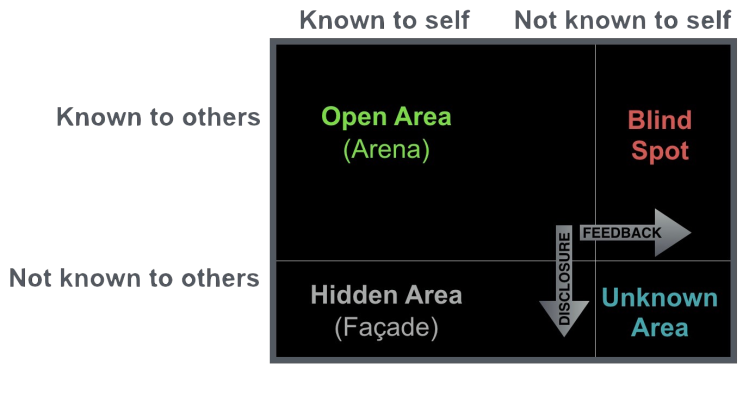![]()
Self-awareness, and having an awareness of others, are two prevalent traits in the individuals of high performing teams.
But why is this the case? Simply put, these characteristics help to generate learning, respect, and collaboration, which ultimately creates strong team cohesion and a culture of excellence.
Of course, not all teams work well together, so how can we create more cohesion in collectives such as these? It’s time to go through the Johari Window.
Created in 1955 by psychologists Joseph Left and Harrington Ingham, the Johari Window is a simple and useful model for illustrating and developing self-awareness, and mutual understanding, between individuals within a team.
The model is based on two assumptions…
- That trust can be acquired through revealing information about yourself to others.
- That self-awareness can be developed through receiving feedback from others.
How is it applied?
To begin with, a subject (team-member) is given a list of adjectives, from which he or she chooses the most appropriate words that describe their own personality.
able • accepting • adaptable • bold • brave • calm • caring • cheerful • clever • complex • confident • dependable • dignified • empathetic • energetic • extroverted • friendly • giving • happy • helpful • idealistic • independent • ingenious • intelligent • introverted • kind • knowledgeable • logical • loving • mature • modest • nervous • observant • organised • patient • powerful • proud • quiet • reflective • relaxed • religious • responsive • searching • self-assertive • self-conscious • sensible • sentimental • shy • silly • spontaneous • sympathetic • tense • trustworthy • warm • wise • witty
The remaining peers (team-mates) are then given this same list, with each selecting an equal number of adjectives that they feel describe the subject most closely.
These adjectives are subsequently placed within a grid, referred to as the Johari House by philosopher Charles Handy…

Open Area
Adjectives which are selected by both the subject and his or her peers are placed within the Open (also known as the Arena) quadrant.
This refers to the traits of ourselves that we are aware of, and that others are aware of too.
Example: “Jessica knows that she finds public speaking difficult, and so do her team-mates.”
Hidden Area
Adjectives that have only been selected by the subject, and not by any of his or her peers, are placed within the Hidden (also known as the Façade) quadrant.
This highlights the traits that we know about ourselves, yet are hidden (either purposefully or not) from others.
Example: “Mike knows that he has performance anxiety, but his team-mates do not.”
Blind Spot
Adjectives that are not selected by the subject, but are chosen by his or her peers, are placed within the Blind Spot quadrant.
These are aspects of ourselves that we’re not aware of, yet others are.
Example: “Erin’s team-mates know that she speaks quicker when under pressure, but she is unaware of this.”
Unknown Area
Adjectives not selected by either the subject or his or her peers remain in the Unknown quadrant.
This represents the behaviours or motives of the subject that haven’t been recognised by anyone participating. This is either because they don’t apply to the subject, or as a result of collective ignorance of the existence of these traits.
Example: “Neither Jake nor his team-mates know that he has many effective leadership qualities.”
Improving performance with Johari
When the Johari Window is applied to high performing groups, teams, and organisations that work both collectively and effectively, it’s consistently found that their subjects (players, staff etc.) have many adjectives which are placed in the Open quadrant. In other words, there is a culture that promotes strong self-awareness skills, coupled with a high level of awareness of others.
So how can you reduce the size of the hidden, blind, and unknown areas in your team to create an open and transparent environment? Two words…
- Feedback
- Disclosure

Regular, specific, and clean feedback is essential for developing self-awareness, and disclosure is needed for reducing secrecy and unlocking people’s unknown potential.
For this to be effective, it requires everyone to be honest, open and respectful with one another.
But moving onto the most important question…why is it called the Johari Window? Well, here’s a clue…
…think about the first names of the creators, Joseph and Harrington 🙂
Would you like to support my writing? Click here to find out more

Interesting
LikeLiked by 1 person
Nathan, another excellent post, thanks. Spookily, we were reviewing the Johari Window on Tuesday at work … and then I read your article which aligned beautifully to the work we were doing. Johari may be an oldie, but it’s a real goldie – and one I return to often to begin a conversation about self-awareness and communication. Thanks.
LikeLiked by 1 person
It’s really my pleasure Christine…feedback like this makes it all worthwhile! Thank you 🙏
LikeLiked by 1 person